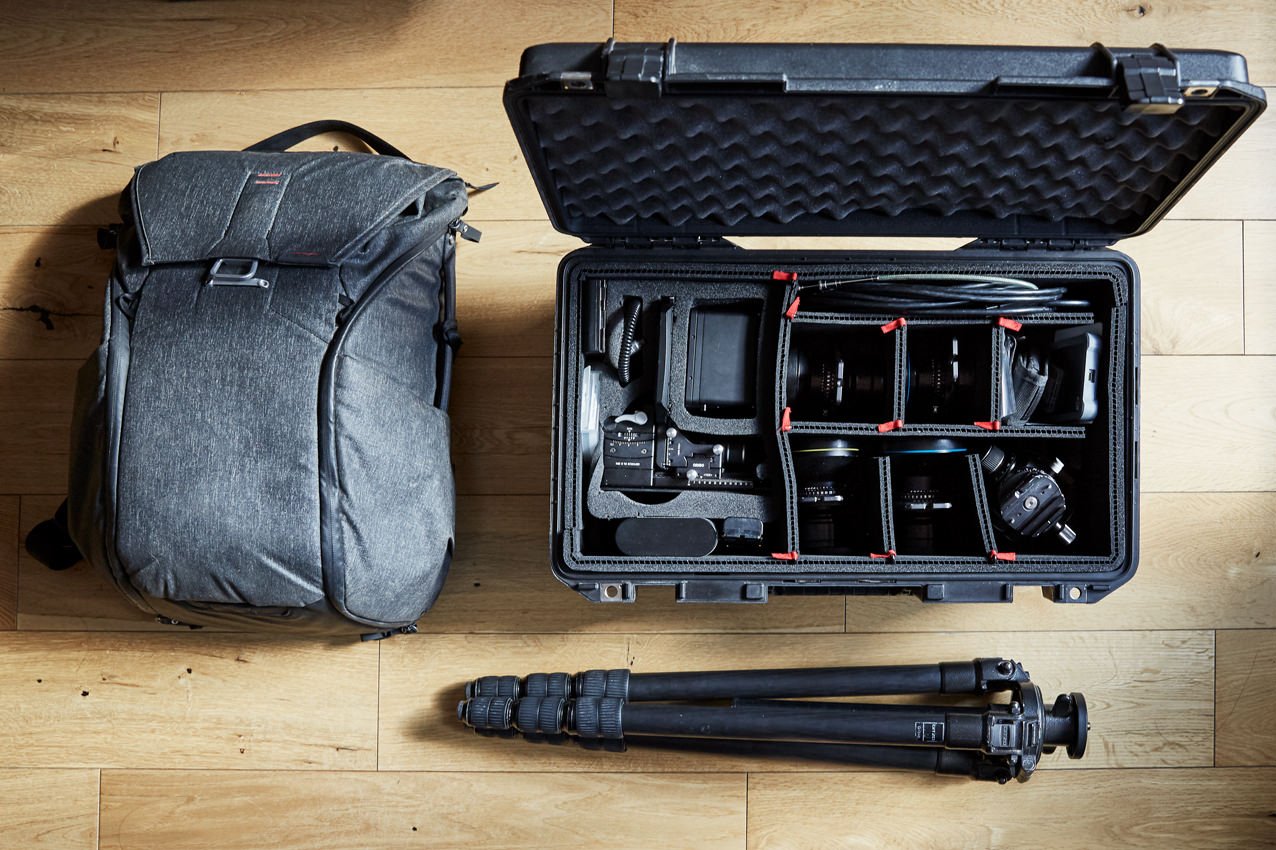Gear for an Architectural and Interior Design Shoot
A question I am frequently asked is - what equipment do you use? Architectural and Interior Design photography is a niche that requires specialist equipment, including very high resolution sensors, and lenses and camera systems that allow for 'tilt and shift'. This is a form of perspective control, which allows vertical lines to remain straight - effectively one can 'look up' without the vertical lines of a building converging as they get to the top. This is also useful for interiors, as having parallel lines generally means for a cleaner looking, more aesthetically pleasing image. I'll be doing a blog post dedicated to tilt and shift, and its uses, at a later date.
My basic gear laid out
Above is the basic kit that I bring to every shoot. My main camera is a medium format Cambo / Phase One technical camera with Rodenstock lenses. These lenses provide the very best optics on the market, in a range of focal lengths. I also have a mirrorless Sony camera for handheld shots, for situations that require more mobility, and as a backup. Again, there is a range of tilt/shift lenses at varying increments of focal length, this time made by Canon. Below is a complete list of each bit of gear, left to right and top down.
Laptop - I generally shoot 'tethered', meaning I can control the camera from the laptop, and review shots as they are taken full-screen.
Sony A7Riii - this great little mirrorless camera has 42MP, superb colour rendition and excellent noise at higher ISO.
Canon EF Telephoto Zoom 100-400mm f/4.5-5.6 - really useful for building details, or for shooting cityscapes from a long way away.
USB 3 cable - for connecting cameras to the laptop.
Canon EF 24-70mm f/2.8L - useful for handheld shots, this zoom lens is remarkably sharp.
Canon TS-E 17mm F/4.0L - super wide lens for when you can't get far enough back!
Canon TS-E 24mm F/3.5L II - the workhorse for the smaller camera. Most of my mirrorless pictures are shot with this.
Canon TS-E 50mm f/2.8L - really nice focal length with lots of shift.
Canon TS-E 90mm f/2.8 - longer lens with tilt shift capability. This short telephoto doesn't have much shift, but is the sharpest of my Canon lenses.
Bellows - these act as the 'camera body' between the lens and the sensor on the medium format system. They are leather and malleable, allowing for lots of shift.
Arca Swiss D4 Head - the best lightweight tripod head you can buy. Can take a massive load for its size. The geared knobs are a joy to work with!
Rodenstock HR Digaron-W 32mm f/4 - equivalent to a 24mm DSLR lens on my system, this lens is unbelievable, incredibly sharp edge to edge with no distortion or chromatic aberration. The benchmark.
Rodenstock HR Digaron-W 40mm f/4 - as above, but equivalent to a 35mm DSLR lens. My favourite focal length for shooting interiors - it's wide, but you don't get any stretching at the edge of the lens.
Rodenstock HR Digaron-W 70mm f/5.6 - great for mid range subjects and details.
Rodenstock HR Digaron-SW 90mm f/5.6 - possibly the greatest lens ever made, the quality is ridiculous. Enormous image circle and pretty much flawless.
Cambo Actus - this is the technical camera, and is essentially the framework which lens/bellows/digital back attach to. More info below.
Polarising Filter - to tackle harsh reflections coming at an angle to the lens plane.
Shutter Release - so we don't wobble the camera when taking a shot.
Leatherman - invaluable on shoots for fixing kit, cutting paper, threatening people etc
Lead - this allows the lens and the digital back to speak to each other.
Phase One IQ150 - digital back which houses the medium format 50MP sensor. Phase One are makers of the best digital backs out there.
Cambo Actus Technical Camera with Rodenstock 32mm HR lens, Phase One Digital Back and Arca Swiss D4 Head
Above is the technical camera put together. It allows for huge amounts of tilt, shift and swing. The Arca Swiss head is easy to get perfectly straight with micro-adjustments, and the Cambo Actus rail slots directly into the mount, so it's super steady and secure. All those dials and knobs mean that I can create very precise compositions while maintaining the best possible image quality for every shot.
It may seem that all of this is a lot to bring to a shoot, but really it all packs down into one regular Peli Air case, one rucksack and a tripod bag. When working as a real estate photographer especially, it's important to be neat and tidy on site, and when shooting overseas, my equipment needs to be easily taken on a plane. It's a very compact kit, so I usually manage to cause very little disruption wherever we are shooting :) Bags for reflectors, black out curtains and so on can be a bit bulky, but I can just about carry everything needed for a regular shoot on my own from car to location. I treat it as an extra workout!
I've not mentioned my superb Gitzo tripod, and this is really the foundation of the set up. If you're interested in architectural or landscape photography, it's worth getting the best quality tripod you can afford, it makes such a difference.
Usually I prefer to shoot using available light (mainly daylight that I can bounce / reflect / flag) but sometimes extra lighting is required. For this I use a Profoto B1X Air system. It's pretty powerful (500W per head), comes with a range of light modifiers, is very lightweight and completely cable free!
Image courtesy of Profoto




